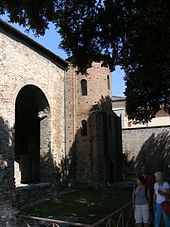So-called palace of Theodoric
The so-called Palace of Theodoric (ital. Cosiddetto Palazzo di Teodorico , abbreviated CD Palazzo di Teodorico ) is a historical building fragment used as a museum in the northern Italian city of Ravenna , which for a time as part of the Palace Theodoric d. Size had been viewed.
The building fragment, which dates from the 8th century, has a 20-meter-long facade and stands on the edge of the imperial area of Ravenna, on which the palace of the regent Galla Placidia and later the palace of Theodoric (another building) had already stood. Due to its location in the immediate vicinity of Theodoric's court church, San Apollinare Nuovo , and due to a certain similarity of its facade with a mosaic representation of the palace of Theodoric, which has been preserved in S. Apollinare Nuovo, the building was erroneously part of the palace in the past Theodoric has been viewed. The original purpose of the building is not clear. Several simple, square capitals of the columns built into the facade have been provided with the cross symbol, which allows the conclusion that the building served a church purpose. Italian historians and the municipality of Ravenna currently assume that it is part of the disappeared church of San Salvatore ad Calchi.
As Corrado Ricci carried out excavations of foundations and wall remains in the gardens of the Monghini family and in the rest of the area between Viale Farini and Via Alberoni between 1907 and 1911 have shown, the palace of Theodoric was located behind the building, which is known as the palace of Theodoric . Both the location of the palace and its ground plan could be determined.
During the excavations, among other things, remains of mosaic floors were found. The mosaic floors were moved to the top floor of the so-called Theodoric Palace in 1923, which was set up as an exhibition space. On this occasion, the spiral staircase leading to the upper floor was also restored. In the exhibition room on the upper floor, a plan of the excavated foundations is shown, from which the floor plans of the palace complex can be seen.
In the so-called palace of Theodoric, a porphyry tub was walled in at the lower right . The tub had been exhibited for a while in the National Museum of Ravenna and is currently in the middle of the upper floor of Theodoric's tomb, the chapel room. The damaged tub, which has cannonball impacts on all sides and one of the head ends of which is incomplete, was originally around 3 meters long, 1.50 meters wide, 1 meter high and 65 centimeters deep. The bottom of the tub is 210 centimeters long and 70 centimeters wide and has irregular semicircular borders at the two head ends. The side walls are sloping and a little steeper on the long sides (slope approx. 70 °) than at the head ends (slope approx. 60 °), on which a person sitting in the tub can comfortably lean. The roughly 16 centimeter thick walls have a smooth, polished surface on both the inside and outside. On one long side there is a bas-relief of a lion's head in the lower center. Both long sides have a bas-relief on the left and right with the motif of a large, thick anchor ring. The tub has an edgeless, gently rounded upper edge that protrudes 1.5 centimeters to the outside and thus offers a person in the tub a firm hold. A person in the tub can comfortably sit down or support himself on the side edge of the tub. A person standing in the tub stands 35 cm above the floor on which the tub is placed - a suitable position for staff standing in front of the tub to dry off or towel them off. It is incomprehensible that the tub - apparently a late Roman bathtub - which does not have any royal insignia or inscriptions, is now exhibited on the upper floor of Theodoric's tomb .
Until 2016, no admission was charged for a visit to the so-called Palace of Theodoric and its exhibition space. An entrance fee of € 1 has been charged since November 2016 (as of September 2017).
Individual evidence
- ^ Wilhelm Jänecke : The three issues at the grave of Theoderich , session reports of the Heidelberg Academy of Sciences, Philosophical-historical class, born 1927/28, Winter, Heidelberg 1928.
- ↑ The fact that the Byzantine emperors were also buried in porphyry sarcophagi, porphyry was a material reserved for rulers in antiquity, may have played a role in bringing the tub to Theodoric's mausoleum.
- ↑ At the caretaker's hut at the entrance there is a list that visitors can sign up voluntarily. It is advisable to add yourself to the list because it serves to document public interest in the exhibition.
Coordinates: 44 ° 24 ′ 58 ″ N , 12 ° 12 ′ 17 ″ E




